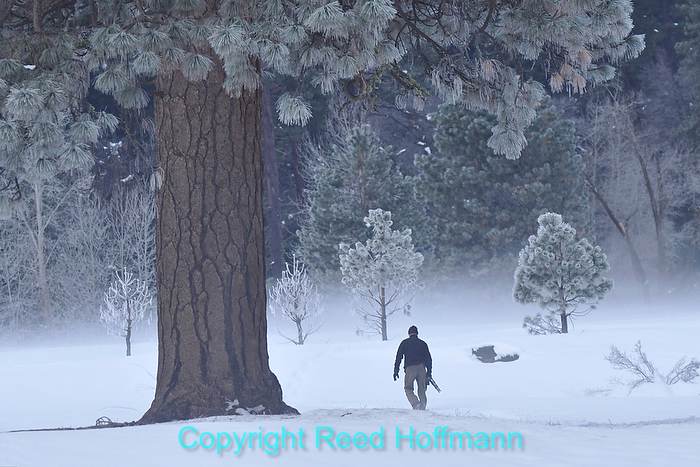For photographers, staying warm in cold weather isn’t just about comfort, it’s about staying focused on photography. If you’re uncomfortable, you’re distracted. In my previous life as a newspaper photographer, I spent twenty years living and working in upstate New York, where winter lasts about half the year. During that time I also took up winter mountaineering as a hobby (which is when my wife realized that yes, I’m crazy). Those two taught me a few things about surviving, and even thriving, in cold weather.
First things first, staying warm is all about insulation and staying dry. Thickness means warmth. There’s no secret material that is thin and will keep you as warm as something thick. It’s like the difference between a sheet and a comforter. Down jackets can keep you warm because the “loft’ of the down creates thickness, without being heavy. However, being too warm means sweat, which can cool you down. That means we need to talk about layers.
Dressing in layers means you can peel off (or unzip) outer layers if you get too warm, and add layers if you get cold. Start with a thin base layer (underwear, long or short), then build from there. If it’s really cold, I’ll have a base layer of heavy long underwear, top and bottom, then zip-neck turtleneck, fleece pants and fleece vest, underneath ski pants below and a down jacket above. I might also add an un-lined parka on top of the down jacket to provide an extra layer, plus wind and rain resistance (down doesn’t insulate if wet, and takes forever to dry).

This is my standard outfit for covering a Chiefs game in cold weather. Since most of the time is spent standing or kneeling (not much activity), we have to dress warmer than if we were on the move more. (Photo copyright John Sleezer)
All of these layers (except the down coat) are made of synthetic materials, no cotton. Cotton holds water and is slow to dry, which is great for keeping you cool in hot weather. In the cold, though, cotton is known as a killer. If it gets wet (even by sweat), it will stay wet and suck the warmth from your body. Synthetic materials will dry quickly, just by body heat. For my winter mountaineering trips, climbing mountains in the Adirondacks with a 40-lb pack while wearing snowshoes, I’d usually hike in a just a turtleneck with a windbreaker over it. As long as I was moving that outfit worked well down to 10-degrees. If I wore more than that, I’d be sweating. When we stopped for a break, though, the first thing I’d do was pull my down jacket out of the pack. Otherwise I’d turn be a popsicle in about 30-seconds.
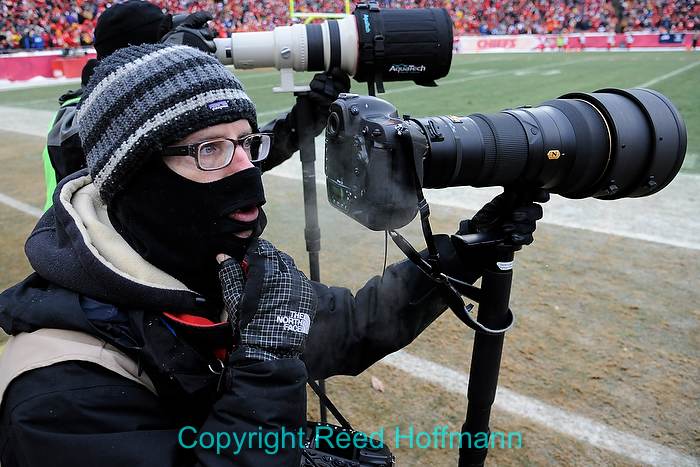
David Eulitt of the Kansas City Star, who covers the Chiefs as part of his beat for the paper, doubles up on headwear in the cold. (Photo copyright Reed Hoffmann)
Headwear’s important too. That means both high insulating value and good at blocking wind, and it has to cover your ears. Cold weather’s no time for a baseball cap. And don’t forget to protect your neck too, both front and back. That’s the reason I’m a big fan of turtlenecks, though scarves can do that too.
The hands are the biggest challenge. Mittens are great if you don’t need your fingers, which generally rules them out for us. Thick gloves are great too, but if you can’t change lenses, push buttons and move dials, then you’ll always be taking them off. And remember, those cameras and lenses are made of plastic and metal, which means they’ll be COLD. For most people, a pairing of thin gloves for shooting and thick gloves (or even mittens) to warm your hands when not shooting is the best solution. Over the years I’ve bought a couple dozen pairs of gloves and mittens trying to find the perfect ones. The two best pairs I’ve ever found were cross-country ski gloves. Skiers need their fingers and wind protection, so they have a good balance of warmth and dexterity. And you can find gloves and mittens where the ends peel back to expose your fingertips. They work well too, though I still recommend thin gloves underneath.
Good footwear’s important too, since numb feet are never fun. The trick again is insulation. What works best for me is a thin pair of synthetic socks under thicker wool ones, with a comfortable (not tight-fitting) boot. Since what you’re standing on will probably be cold (ice, snow, frozen ground, concrete…), you need good insulation from below too. When I shoot ski racing, I always take along a small insulated pad to stand on, to help keep the snow from radiating the cold up into my feet.
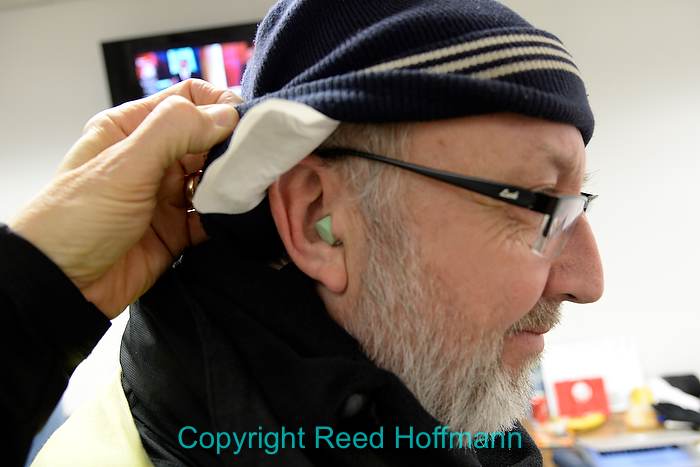
Charlie Riedel showing off his latest cold-weather accessory, toe-warmers inside the hat. (Photo copyright Reed Hoffmann)
Beyond clothing there are a few extra accessories that can help. Chemical hand and toe warmers are small one-time-use packs that when exposed to air heat up. One of those stuffed into the palm of a glove can do wonders to help keep your fingers working. Years ago I also bought what I call a “belly pouch,” the same thing quarterbacks use in cold weather to warm their hands. I’ll wear that and put a couple of hand-warmers in it too. Toe warmers can sometimes help, but my experience is that they’re only good for about an hour. A friend showed me another good use for them, putting a pair in his hat to keep his ears warm. And in my continuing efforts to find ways to keep my toes warm, last year I bought an inexpensive pair of electric socks (about $30) that do a decent job. You can get really serious electric foot warmers, which some skiers use, but they’ll cost a couple hundred dollars.
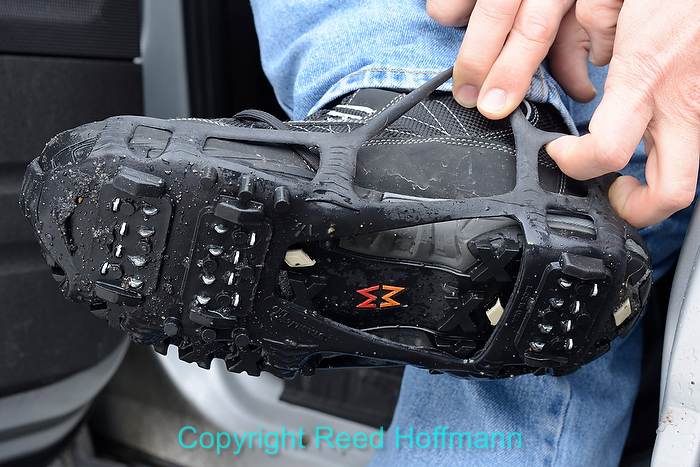
These “ice-creepers” can literally be a life-saver is you’re on slick surfaces. (Photo copyright Reed Hoffmann)
If you’re going to be walking on ice, then I strongly recommend getting a pair of “ice creepers.” Last year I joined some friends for a trip to Yosemite in January, and arriving, we found that a recent warm spell had turned much of the snow to ice. While in the camp store for some other things, one of our group found a rack of these rubber straps with metal studs on the bottom. The $25 I spent on those might have been the most important purchase I made in 2013. It’s simply too easy to slip and fall on ice, and that would be bad enough without dropping a bunch of expensive camera gear. Think of these things as cheap insurance.
Batteries tend to drain faster in cold weather, but recent advance in technology means that most of the time, today’s batteries outlast photographers. Having said that, I still recommend carrying at least one spare, and inside your clothing where your body heat will keep it warm.
Finally, there are a couple of things you might want to do with/to your tripod. Carbon-fiber doesn’t get as cold as metal, but I still recommend foam wraps for at least two of the upper legs. Makes them much more comfortable to pick up and carry. If you’re in snow that’s more than a couple of inches deep, there are tripod snowshoes you can put on the feet, to keep them from sinking in so far. When you get back indoors with the tripod, remember to extend all the legs so they have a chance to dry out. In fact that’s a good idea with all your gear anytime you’ve been out when it’s wet, damp, or snowy – unpack everything once inside and make sure it all dries out. That way it should be ready for the next outing.
In photography, different is usually good. Which means that when there’s bad weather, that can often be a good opportunity for some unique photos. I hate shooting in rain, but love getting out in the snow. And properly prepared, I can have a lot of fun out there, stay comfortable, and make some nice pictures.
(If you think winter photography sounds fun, then join me in January of 2015 for a unique and special week in Yellowstone National Park. We’ll stay in heated lodges and travel by van, car, snow cat, foot and snowshoe. Drop me a note if you’re interested – reed@reedhoffmann.com)
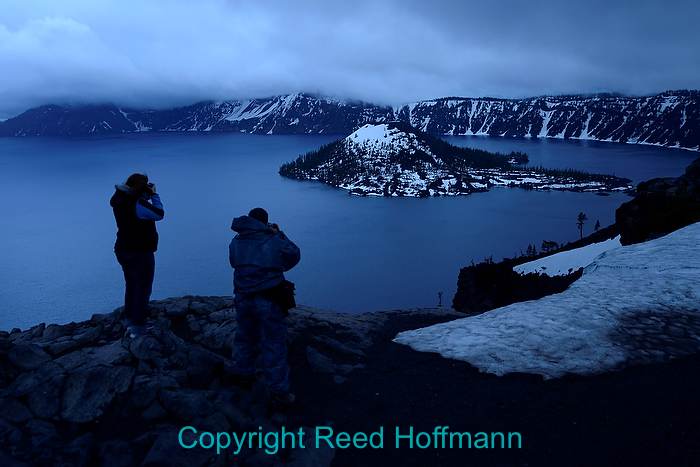
With the right gear, forbidding winter weather can be the perfect time to get out and make some amazing photos. (Photo copyright Reed Hoffmann)

